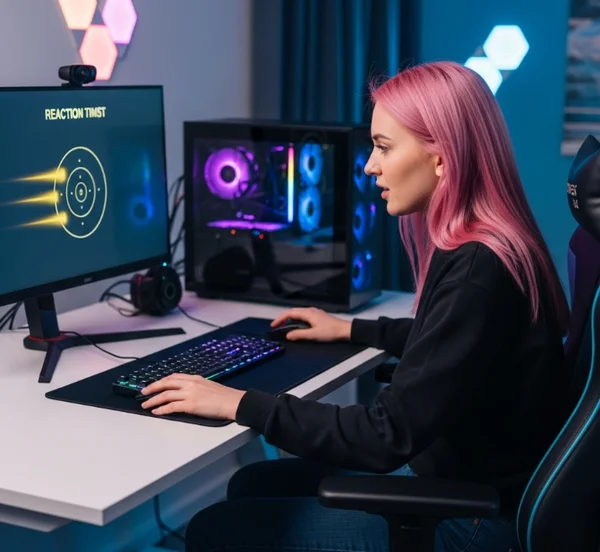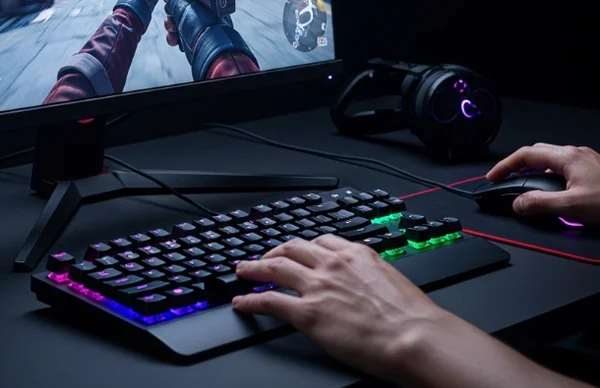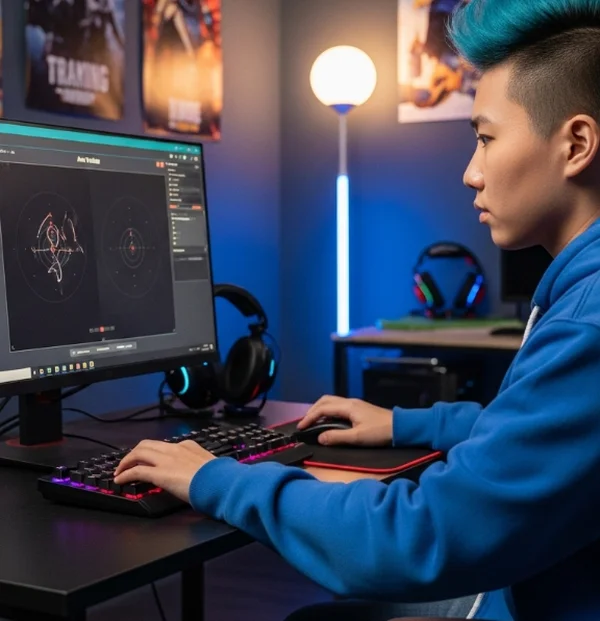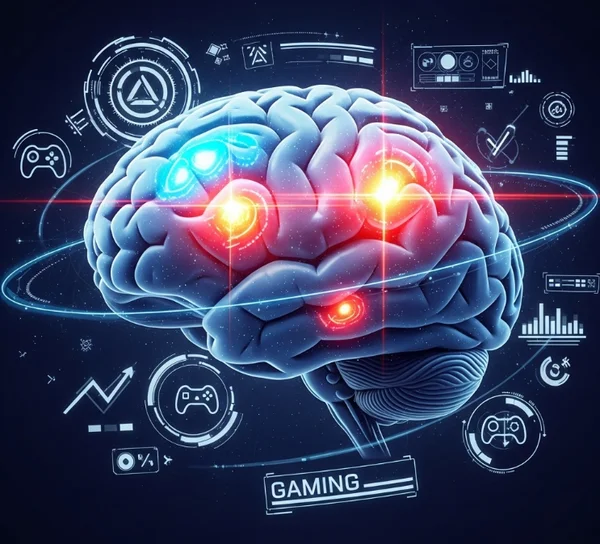Reaction Time for Gamers: Tips for a Competitive Edge
Hey fellow gamers! Ever felt like you almost got that headshot, almost dodged that ability, or almost clutched that round? In the fast-paced world of gaming, milliseconds decide winners. If you've been wondering How to increase reaction time for gaming?, you're in the right place. Improving your reaction time gaming isn't just about bragging rights; it's about unlocking your true potential and gaining that crucial competitive edge. Our site provides a fantastic way to test your current gaming reaction by seeing how quickly you respond when the color changes from red to green. This guide will dive into actionable tips to sharpen those gaming reflexes.
Understanding Your Current Gaming Reaction Time
Before you can improve, you need a baseline. How to test my gaming reaction time? Knowing your starting point helps you track progress and identify areas for improvement.
The Importance of Benchmarking Your Reflexes
Think of it like leveling up in a game. You need to know your current stats to see how far you've come. Benchmarking your gaming reflexes gives you a concrete number to work with. This initial click speed test or visual reaction assessment is vital.

Using a Reaction Time Test for Gamers
A dedicated reaction time test designed with gamers in mind can be invaluable. While many tools exist, a simple visual cue test, like the one we offer where you click when red turns green, is a great starting point. It measures your raw visual reaction speed, a core component of fast reaction time gaming. Try our reaction test for gamers now to get your baseline!
Key Strategies to Improve Reaction Time for Gaming
Ready to shave off those crucial milliseconds? Let's explore some top-tier strategies to improve reaction time gaming.
Optimize Your Gaming Setup (Reduce Gaming Lag & Enhance FPS)
Your gear and settings can be your best friend or worst enemy. Does FPS affect reaction time? Absolutely! A smoother experience means your brain gets information faster.
Minimizing Input Lag: Monitor, Mouse, and Keyboard
Input lag is the delay between your action (like a mouse click) and it appearing on screen. Opt for low latency peripherals – gaming monitors with high refresh rates (Hz) and low response times (ms), and responsive gaming mice and keyboards. Reducing this lag directly translates to quicker in-game actions.

Boosting FPS: Graphics Settings and System Tweaks
Higher and more stable Frames Per Second (FPS) means smoother visuals. This allows you to perceive and react to on-screen events more quickly. Tweak your in-game graphics settings, update drivers, and ensure your system is optimized for gaming performance.
Stable Internet Connection for Online Gaming
For online warriors, network latency (ping) is a huge factor. A high ping means your actions take longer to register on the server. Use a wired connection if possible and optimize your router settings to reduce gaming lag.
Targeted Reaction Training for Gamers (Effective Gaming Reaction Exercises)
Practice makes perfect, and this is especially true for reaction training for gamers.
Utilizing Aim Trainers and Reflex Drills
Tools like KovaaK's, Aim Lab, or even simpler online visual reaction test for gamers can significantly hone your gaming reaction exercises. These aim trainers often have specific drills for flick shots, tracking, and click timing. You can also use our basic reflex drill as part of your routine.

Specific In-Game Scenario Practice
Identify high-pressure situations in your favorite games where quick reflexes are critical. Practice these scenarios repeatedly. This could be entry fragging in an FPS, last-hitting in a MOBA, or parrying in a fighting game.
Visual and Auditory Cue Training
Games often provide both visual and auditory cues. Train yourself to react to both. This multi-sensory approach can improve your overall reaction time gaming.
Enhancing Cognitive Skills for Faster Reactions (Brain Training for Gamers)
Your brain is your ultimate gaming peripheral. Sharpening your cognitive skills is key to improve reaction time gaming.
Improving Focus and Concentration
The ability to maintain intense focus during chaotic moments is crucial. Practice mindfulness or use techniques like the Pomodoro method to enhance sustained attention. Better brain training for gamers leads to faster reactions.

Developing Pattern Recognition and Prediction
Experienced gamers often seem to react "before" something happens. This is due to highly developed pattern recognition and prediction skills. Analyze gameplay, study opponent tendencies, and learn to anticipate moves.
Stress Management and Maintaining Composure
Performing under pressure is a hallmark of a great gamer. High stress can cripple your gaming reflexes. Learn simple breathing exercises or stress-reduction techniques to stay calm and reactive.
Lifestyle Habits for Peak Gaming Performance (Healthy Habits for Fast Reaction Time Gaming)
Your off-screen habits significantly impact your on-screen gaming performance.
The Role of Quality Sleep
We can't stress this enough: quality sleep is non-negotiable for fast reaction time gaming. A rested mind processes information faster.
Nutrition and Hydration for Gamers
Your brain needs fuel. A balanced diet and proper hydration keep your cognitive functions, including reaction speed, at their peak.
Regular Physical Exercise
Physical activity improves blood flow to the brain, enhances alertness, and can even improve your reaction time test scores.
Tracking Your Progress: The Importance of Consistent Testing
As you implement these strategies, how do you know they're working? Consistent testing! Regularly revisit a reaction time test to monitor your improvement. Seeing those milliseconds drop is incredibly motivating and helps you refine your reaction training for gamers. Track your gaming reflex progress here.
Dominate the Game with Superior Reaction Time
Improving your reaction time gaming is a journey, not a destination. It requires a holistic approach encompassing your setup, targeted practice, cognitive enhancement, and healthy lifestyle choices. By focusing on these areas, you can significantly sharpen your gaming reflexes and gain that coveted competitive edge. Start today, stay consistent, and watch your gaming performance soar!
What are your favorite techniques to boost your reaction speed for gaming? Share your pro tips in the comments below!
Gamer's Edge Reaction Time Questions Answered
-
What is a good reaction time for gaming?
While it varies by game and individual, many competitive gamers aim for visual reaction times below 200ms, with pros often achieving 150ms or even lower. The
best reaction time for gamingis always the fastest you can reliably achieve! Find out your score. -
Can I improve my gaming reflexes?
Absolutely! While there's a genetic component,
gaming reflexesare highly trainable. Consistent practice withgaming reaction exercises, optimizing your setup, and healthy habits can lead to significant improvements in yourreaction time gaming. -
How long does it take to see improvements in gaming reflexes?
This varies greatly. Some players might see small improvements in their
click speed testscores within a few weeks of dedicatedreaction training for gamers, while more substantial gains might take months. Consistency is key. -
Are there specific games that are best for reaction training?
Fast-paced FPS games (like Valorant, CS:GO, Apex Legends), rhythm games (like Osu!), and some arcade-style games can be excellent for naturally training your
quick reflexes. However, dedicatedaim trainersandreaction testtools offer more focused practice. -
Does a higher refresh rate (Hz) monitor directly improve my reaction time?
A higher refresh rate monitor (e.g., 144Hz, 240Hz) doesn't make your brain process information faster, but it displays information on the screen more frequently and smoothly. This reduces display lag and provides you with visual information sooner, allowing your already existing
reaction speedto be applied more effectively in-game. So, it helps you utilize yourfast reaction time gamingbetter.